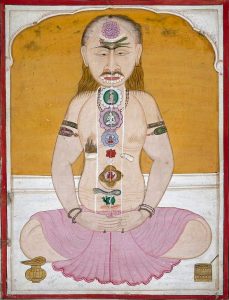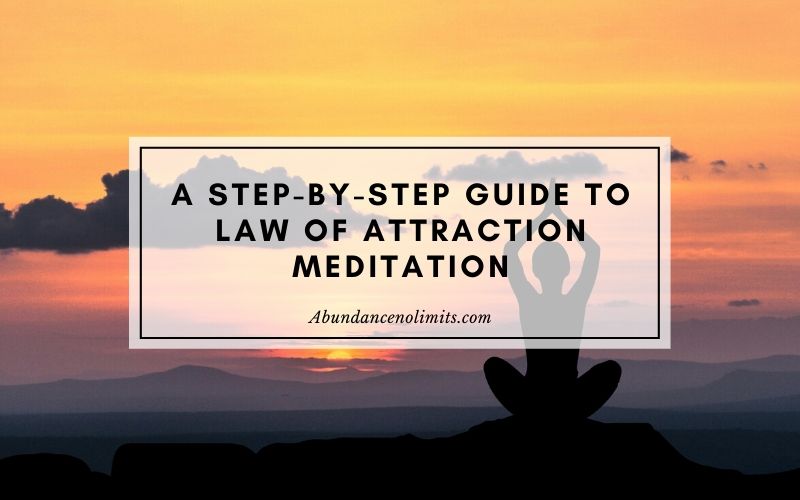Are you looking for ways to improve your way of life? The law of attraction is the answer you are seeking. The law of attraction techniques offers you the best chance of making your dreams come true. Yes, I can see the next question coming. How can you better your experience with the law of attraction? The only answer is the law of attraction meditation.
The law of attraction meditation offers a wide array of rewards to regular practitioners of the ancient craft. The physical and mental benefits include better focus, positive outlook, reduced levels of anxiety, and an overall improvement in general health. Read on to find more about the law of attraction meditation, its benefits, types of meditation, and stepwise instructions for beginners to meditation.
What is the meditation for law of attraction?
The law of attraction is a concept and lifestyle based on the idea of ‘like attracts like’. You will attract whatever you are focussing on. To get the best results, you need to concentrate on good and positive things. This is where meditating can help.
The law of attraction meditation helps shift your mental attention from the chaotic mess of negative emotions to a happy and peaceful state. Emotions are our natural companions in life and nothing to be ashamed of. However, if allowed to get out of control, they can easily wreck our lives. Meditation can help in keeping them in check and shift the focus from negative emotions to positive ones.
To help you stay on track on manifesting with the law of attraction, numerous law of attraction apps are available on the Play Store and the App Store. One such useful law of attraction app is the Law of Attraction Toolbox App. It comes highly recommended with rave reviews from its users.
How can meditation help in manifestation?
When you are trying to manifest success, love, health, abundance, or anything else in life with the law of attraction techniques, you need to focus all your energy on that one desire. Focusing is a challenge for most of us, even if the reward is coveted. Our mind races like a runaway horse every time we try to concentrate. Training our minds to focus on a single thing is best achieved through meditation. Meditation is all about focussing on our breathing or a mantra. Regular practice can bring discipline to our minds.
Meditation can also help in calming down the mind and bring in happiness and tranquility in life. The incessant brain chatter is a huge liability when attempting manifestation. Meditation can come in handy in getting rid of this and fill up the mind with serene and positive thoughts.
Visualization is an important part of manifestation. While you can visualize making your dream come true, it is more effective when you practice visualization meditation. It combines the practice of meditation with the technique of visualization. In this, you visualize the realization of your desire while meditating. When you meditate, your mind is focussing while your body is relaxing. This is the perfect setting to practice visualization.
Guided meditation for manifesting is a simple form of meditation done with the help of a guide. Best suited for beginners, guided meditation offers you the advantage of an expert to guide you through the initial struggling phase. When a skillful practitioner of meditation is available close at hand to guide you through the process, you will find it reassuring and supportive. The instructions and encouraging words of the guide will help you to focus on your breathing in a better manner.
Benefits of Meditation
Meditation extends a wide range of rewards, especially for a practitioner of the law of attraction. Daily meditation has an amazing impact on physical as well as mental health. It even acts as a bridge between the two. The wide-ranging health benefits of meditation are
- Improved focus on positive things
- Enhanced clarity of mind
- Drives out depression and negative thoughts
- Better ability to put things in perspective
- More sense of peace and purpose
- Higher levels of compassion
- Greater self-acceptance
- Sounder connection between mind and body
- Reduced levels of anxiety and panic attacks
- Better sleep and improved immune system

Types of Meditation
The rewards offered by meditation are somewhat similar, irrespective of which form of meditation you follow. You can choose from any of these methods of meditation depending on your preferences and comfort level. However, some meditation methods are suitable for certain personality types and some offer better benefits in certain areas.
Kundalini meditation: or Kundalini Yoga is a physically active form of meditation. It combines body movements with deep breathing and mantras. This meditative practice helps in improving energy levels and bettering mental health.
Mindfulness meditation: is a simple form of meditation that focuses on your breathing to help you stay in the present moment. Instead of fretting over the past or scared of the future, it encourages you to stay in touch with your surroundings without judgment.
Breath awareness meditation: or heart rhythm meditation focuses on your breathing and heartbeat to get you in tune with your environment. The goal is to eliminate thoughts and keep your mind blank while meditating. It offers benefits like better concentration, lower levels of anxiety, and more control over emotions.
Transcendental Meditation: is a spiritual form of meditation that offers enlightenment and a peaceful mind. The aim is to transcend or go past the present state. It helps in swapping negative thoughts with positive ones and slow down the pace of life.
Guided Visualization Meditation: concentrates on visualizing a future goal to make it appear real at present and ultimately attain it. This guided meditating technique is more in alignment with the ideals of the law of attraction. It helps in altering your vibrational frequency to match your desire.

Meditating in 5 steps
These steps are useful for initiation into meditation.
Step1: Find a quiet and peaceful spot
It is important to meditate in a calm and tranquil place devoid of noise and distraction. This is more crucial for a beginner. When you sit down to meditate for the first time, it is natural to find your mind wandering. Background sounds like conversations, loud music, or television can make it difficult for you to concentrate and keep your mind still. However, there is meditation music available that can help in the process. These are soothing music played softly in the background in a nonintrusive way.
You can choose to meditate indoors or outdoors, but the spot you choose should have a comfortable temperature; neither too cold nor too hot. Extreme weather conditions won’t help you.
The same rule applies to your seating arrangement. Use a cushion if necessary. The point is to make yourself as comfortable as possible to avoid any kind of distraction.
Step 2: Posture
While posture has a significant role in the success of a meditative session, it is also vital that you are at ease. The ideal posture when meditating is to sit cross-legged with hands placed on your lap. As you have to maintain this posture for the entire duration, don’t force yourself if it is not comfortable. Choose a posture you can manage in the beginning. It is okay to sit in a chair or kneel. You can move on to the cross-legged posture later on. One crucial point to remember is to keep you back straight and not slouch while meditating.
Step 3: Focus on your breathing
Irrespective of the type of meditation you choose, emphasis on breathing is common to all of them. This is to help you calm down and focus and get you ready for the actual meditation process. Learn to breathe the right way and master the technique of deep breathing. It may take you a few attempts to get these right.
Once you are ready to meditate, close your eyes, and concentrate on your normal breathing. Your abdomen should expand when you inhale and should deflate when you exhale. You would be shocked to know that most people do it the other way!
After a couple of minutes of normal breathing, move on to deep breathing. There are deep breathing techniques that require you to hold your breath between inhaling and exhaling.
Step 4: Concentrate on your thoughts
Once your mind has settled down with a few minutes of deep breathing, come back to normal breathing. Focus on the breath coming in and going out. It is not as easy as it sounds. It requires some effort to maintain your attention solely on your breathing. Soon your mind would begin to wander.
Don’t feel upset by your mind’s drifting nature. It is normal. Don’t fight against it. Be kind to yourself. Don’t judge or obsess over your thoughts. Let it drift for some time and gradually bring it back to focus on your breathing.
In the beginning, you will find it difficult to maintain your focus even for a short duration. As you practice more and gain experience, you will find it easier.
Step 5: Finish with tranquility
Once you are ready to end the session, pay attention to your surroundings. Notice the sounds and movements around you. Then shift your attention to your body. Notice your thoughts and emotions.
Slowly open your eyes. You should be feeling calm and peaceful.
Tips for beginners
When you are just starting, you need to understand some basic facts. If you sit with your eyes closed for some time, you cannot call it meditation. It is not something that can wipe clean your mind and bring you calm and peace like waving a magic wand. It is something you need to practice for a long while to develop the skill of keeping your mind still. Yes, in some distant future, you can expect to reap the rich rewards!
Meanwhile. here are a few useful hints to help you stay on track.
- Morning is the best time for meditation. Right after waking up, your mind is the calmest and least disturbed. And, you get to enjoy the benefits of meditating for the rest of the day.
- Choose a location with no sounds or background noises, if possible. In case some noises cannot be avoided, listen to soothing music for meditation.
- Your posture is crucial for a successful meditating session. Remember to keep your back straight and don’t slouch. This is helpful to maintain the posture for longer periods. It is also vital to derive the best out of breathing exercises.
- If you are having difficulty focussing on your breathing, you can count while inhaling and exhaling. This will help in keeping your thoughts from wandering and to focus on the task.
- When your mind starts drifting when meditating, don’t feel upset and blame yourself. Even if this happens repeatedly, don’t give up and decide that meditation is not meant for people like you. Everyone starts this way and make steady progress. Whenever this happens, give the mind some rope to wander. Bring it back to focus gently every time you find it drifting.
- Before you begin your meditation journey, you will be full of enthusiasm. You will be thinking more about the gains than the actual process. Once you start meditating, the realization that it is not as easy as you imagined will dawn on you. After a couple of attempts, you may give it up thinking you are not suitable for it. To avoid this, commit yourself even before you begin to stick with it no matter what for a month at least. A month of honest practice will help you get over the initial pangs and gain some basic skills.
Related: Meditation Vs Self-Hypnosis: Which One is Right for You?


